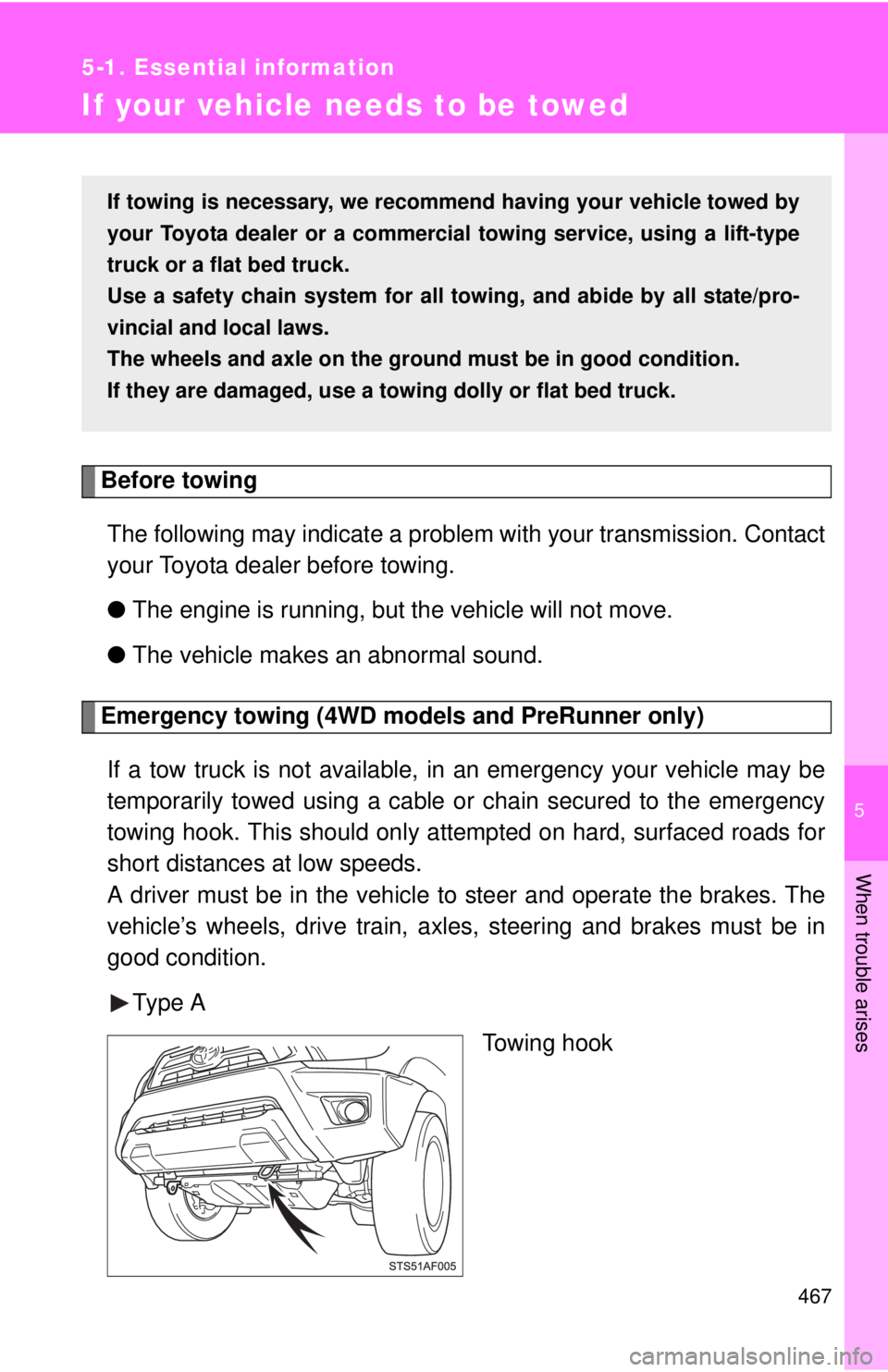Page 450 of 590
450 4-3. Do-it-yourself maintenance
*: Replace the fuse with one of the same ampere rating as the original34 AM2 30 A
IGN and GAUGE fuses, multiport
fuel injection system/sequential
multiport fuel injection system
35 AIR PMP 50 A Multiport fuel injection system/
sequential multiport fuel injection
system
36 ABS NO.2 30 A Anti-lock brake system, vehicle sta-
bility control system
37 INV 100 A Power outlets
38 ALT 120 A*
AM1, AC SKT, HEATER, FR FOG,
STOP, OBD, J/B, TOWING TAIL,
TOWING BRK and BATT CHG
fuses
140 A*
FuseAmpereCircuit
Page 467 of 590

5
When trouble arises
467
5-1. Essential information
If your vehicle needs to be towed
Before towingThe following may indicate a problem with your transmission. Contact
your Toyota dealer before towing.
● The engine is running, but the vehicle will not move.
● The vehicle makes an abnormal sound.
Emergency towing (4WD models and PreRunner only)
If a tow truck is not available, in an emergency your vehicle may be
temporarily towed using a cable or chain secured to the emergency
towing hook. This should only attempted on hard, surfaced roads for
short distances at low speeds.
A driver must be in the vehicle to steer and operate the brakes. The
vehicle’s wheels, drive train, axles, steering and brakes must be in
good condition.
Type A Towing hook
If towing is necessary, we recommend having your vehicle towed by
your Toyota dealer or a commerci al towing service, using a lift-type
truck or a flat bed truck.
Use a safety chain system for all to wing, and abide by all state/pro-
vincial and local laws.
The wheels and axle on the groun d must be in good condition.
If they are damaged, use a towing dolly or flat bed truck.
Page 468 of 590
468 5-1. Essential information
Type BTowing hook
■Emergency towin g procedure
The engine switch must be in the ACC (engine off) or the ON
(engine running) position.
4WD models: Put the front-wheel drive control switch in H2.
Put the shift lever in N.
Release the parking brake.
CAUTION
■ Caution while towing
●Use extreme caution when towing the vehicle.
Avoid sudden starts or erratic driving maneuvers which place excessive
stress on the emergency towing hook and the cables or chains. Always be
cautious of the surroundings and other vehicles while towing.
● If the engine is not running, the power assist for the brakes and steering
will not function, making steering and braking more difficult.
Page 469 of 590
5
When trouble arises
469
5-1. Essential information
Towing with a sling-type truck
NOTICE
■
Emergency towing hook precautions
●Before emergency towing, check that the hook is not broken or damaged.
● Fasten the towing cable or chain securely to the hook.
● Do not jerk the hook. Apply steady and even force.
● To avoid damaging the hook, do not pull from the side or at a vertical
angle. Always pull straight ahead.
NOTICE
■To prevent body damage
Do not tow with a sling-type truck, either from the front or rear.
Page 470 of 590
470 5-1. Essential information
Towing with a wheel lift-type truck from the frontVehicles with an automatic trans-
mission: Use a towing dolly
under the rear wheels.
2WD models with a manual
transmission: We recommend to
use a towing dolly under the rear
wheels.
When not using a towing dolly,
release the parking brake and
shift the shift lever to N.
4WD models with a manual
transmission: We recommend to
use a towing dolly under the rear
wheels.
When not using a towing dolly,
release the parking brake, shift
the shift lever to N and put the
front-wheel drive control switch in
H2.
NOTICE
■To prevent causing serious damage to the transmission (vehicles with
an automatic transmission)
Never tow this vehicle wheels on the ground.
Page 471 of 590
5
When trouble arises
471
5-1. Essential information
Towing with a wheel lift-type truck from the rear
2WD models Turn the engine switch to the
ACC position.
4WD models We recommend to use a towing
dolly under the front wheels.
When not using a towing dolly,
turn the engine switch to the ACC
position, shift the shift lever to N
and put the front-wheel drive con-
trol switch in H2.
NOTICE
■To prevent damaging the vehicle
●Do not tow the vehicle with the key removed or in the LOCK position.
The steering lock mechanism is not strong enough to hold the front wheel
straight.
● When raising the vehicle, ensure adequate ground clearance for towing at
the opposite end of the raised vehicle. Without adequate clearance, the
vehicle could be damaged while being towed.
Page 495 of 590
5
When trouble arises
495
5-2. Steps to take in an emergency
Firmly tighten each nut two or three times in the order shown
in the illustration.
Tightening torque:
83 ft·lbf (113 N·m, 11.5 kgf·m)
2WD models except PreRunner
4WD models and PreRunner
Stowing the flat tire, jack and all tools
Lay down the tire with the outer
side facing up, and install the
holding bracket.
Page 500 of 590

500 5-2. Steps to take in an emergency
NOTICE
■Do not drive the vehicle with a flat tire
Do not continue driving with a flat tire.
Driving even a short distance with a flat tire can damage the tire and the
wheel beyond repair.
■When stowing the flat tire
Ensure that there is no object caught between the tire and the vehicle
underbody.
■When replacing the tires
●When removing or fitting the wheels, tires or the tire pressure warning
valve and transmitter, contact your Toyota dealer as the tire pressure
warning valve and transmitter may be damaged if not handled cor-
rectly.
●Replace the grommets for the tire pressure warning valves and trans-
mitters as well.
■To avoid damage to the tire pressure warning valves and transmit-
ters
When a tire is repaired with liquid sealants, the tire pressure warning
valve and transmitter may not operate properly. If a liquid sealant is
used, contact your Toyota dealer or other qualified service shop as soon
as possible. Make sure to replace the tire pressure warning valve and
transmitter when replacing the tire. ( P. 423)